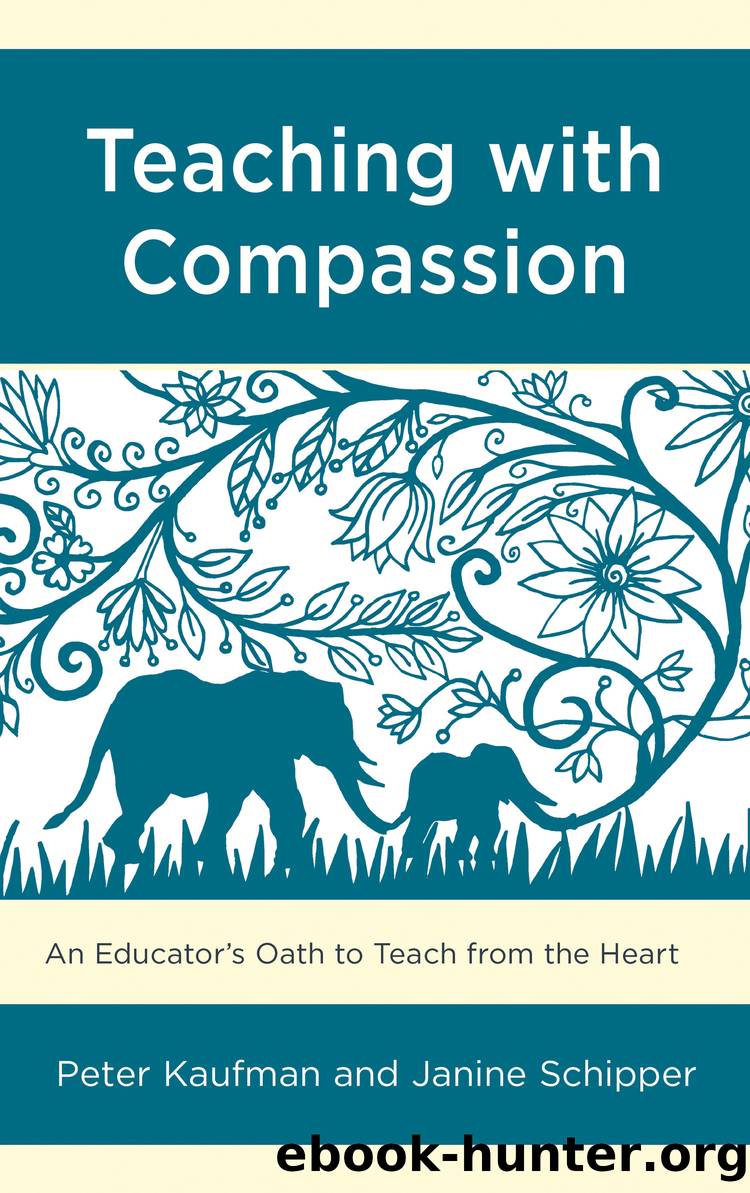Teaching with Compassion by Kaufman Peter;Schipper Janine; & Janine Schipper

Author:Kaufman, Peter;Schipper, Janine; & Janine Schipper [Kaufman, Peter & Schipper, Janine]
Language: eng
Format: epub
Publisher: Rowman & Littlefield Unlimited Model
Published: 2018-06-28T17:18:40+00:00
The Physics of Classroom Chemistry
We also create classroom chemistry through the ways we organize physical space. As many elementary teachers know well, crafting classroom space is an art form in and of itself. Whether it is the kindergarten teacher who carefully arranges the bookshelves, student desks, and learning tables; the science teacher who creates an alluring laboratory full of manipulatives and possibilities; or the special area teacher who goes to great lengths to create an inviting and unique atmosphere that conveys to students the joy of music, art, or physical education, the way in which we set up the learning space says a lot about how we want the educational experience to transpire.
In short, the sensitivity and effort taken to shape classroom space highlights the intentions behind our teaching. And whether those intentions are to ignite and foster a spirit of adventure, optimize skill development, or create a nurturing environment, the care and attention placed in our organization and use of space help us create thriving learning environments where student interactions with the material and with each other can result in great chemistry.5
Even when the material is largely abstract and structural limitations exist, as it is in many college classrooms, we can use space creatively. For instance, in her Introductory Sociology class, which often has over a hundred students and is held in lecture halls with immovable tables and chairs, Janine stages simulations in the aisles, uses the corners of the room and hallways to conduct small group work, and hustles around from group to group encouraging student engagement. She refuses to allow the class size or the room constraints to result in an impersonal and isolating educational experience.
In smaller seminars she uses the entire campus as her classroom, engaging students in walk-and-talks both within and outside of buildings. The graduate student who taught Janine this technique explained, âWhen we walk and talk, sometimes we access different parts of our minds and ourselves than when weâre sitting still in chairs around a table. Youâre often able to delve into a conversation with a friend and go a little more deeply when taking a casual stroll together.â
The point here is to think creatively about how we may manage or even manipulate the space. We know that as physical structures, many classrooms at all levels and at all institutions are not conducive to creating a warm, inviting, and communal learning atmosphere. In our commitment to teaching with compassion, overcoming these structural impediments is often one of our greatest challenges.
The following exercise, creating a Learning Café, is one way to possibly surmount some of the physical limitations to create lasting classroom chemistry.
The objective of the exercise is to honor all student perspectives and create an environment where all voices are heard. Learning Cafés engage students in connecting with their own experiences and diverse ways of knowing and thinking. As facilitators of the Learning Café, teachers have the opportunity to take a step back from being the âsage on the stageâ and instead practice deep listening.
Download
This site does not store any files on its server. We only index and link to content provided by other sites. Please contact the content providers to delete copyright contents if any and email us, we'll remove relevant links or contents immediately.
Chicken Soup for the Soul Presents Teens Talkin' Faith by Jack Canfield(638)
Understanding PDA Autism in Kids: A Guide for Parents and Teachers to Support Neurodiverse Learners by Jehu Len(553)
The Victorian Era: A Captivating Guide to the Life of Queen Victoria and an Era in the History of the United Kingdom Known for Its Hierarchy-Based Social Order by Captivating History(422)
Brain Teasers to Build Critical Thinking Skills by Safarova Kris(411)
Brain Teasers to Build Critical Thinking Skills: Brain Exercises for Tech, Banking, Case Interview Prep, and to Keep Your Mind Sharp by Kris Safarova(411)
100 Ideas for Secondary Teachers: Engaging Parents by Janet Goodall & Kathryn Weston(386)
Python 101 - Fundamentals by Sam(373)
Critical Curriculum Leadership : A Framework for Progressive Education by Rose M. Ylimaki(360)
Writing Solid Code: Development Philosophies for Writing Bug-Free Programs by Steve Maguire(356)
The Art of Emotional Validation: Improve Your Communication Skills and Transform Your Relationships by Validating Emotions and Feelings by Emily Wright(338)
Intersectionality in Educational Research by Dannielle Joy Davis; James L. Olive; Rachelle J. Brunn-Bevel; Susan R. Jones(331)
The Knights Templar: An Enthralling History of the Rise and Fall of the Most Influential Catholic Military Order by Wellman Billy(327)
A Beginner's Guide to SSD Firmware by Unknown(327)
The Future Knowledge Compendium by Ellyard Peter;(319)
How to be assertive in any situation by Hadfield Sue & Hasson Gill(309)
Making Connections in and Through Arts-Based Educational Research by Hala Mreiwed Mindy R. Carter Sara Hashem Candace H. Blake-Amarante(305)
Foundations of Educational Research by Victoria Elliott(305)
What Every Teacher Should Know about Learning, Memory, and the Brain by Tileston Donna E. Walker;(305)
Message from the Pleiades; The Contact Notes of Eduard Billy Meier v1 only by unknow(301)
